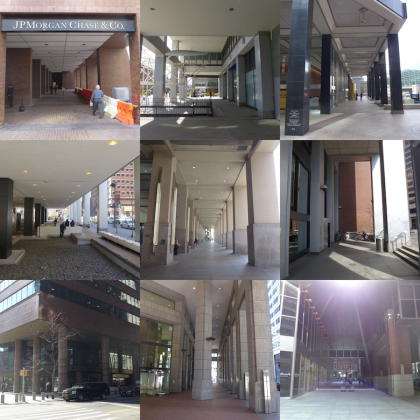Open Letter: The FiDi Arcade Plan Warrants a Closer Look
 An organization called Community Advocates for Public Space sent over a rebuttal—a re-rebuttal?—to Downtown Alliance president Jessica Lappin’s response to my post on the plan to give publicly accessible arcades along Water Street back to the buildings’ owners in exchange for improvements to nearby plazas.
An organization called Community Advocates for Public Space sent over a rebuttal—a re-rebuttal?—to Downtown Alliance president Jessica Lappin’s response to my post on the plan to give publicly accessible arcades along Water Street back to the buildings’ owners in exchange for improvements to nearby plazas.
In response to Ms. Lappin’s critique of the Tribeca Citizen piece, The Great FiDi Landgrab, please note the following important points:
Contrary to the suggestion that the landgrab was community driven, it was not. Community Board 1 relied on presentations given by the Downtown Alliance and New York City Economic Development Corporation. In February, Community Board 1 did not pass the resolution in support of the amendment. In March, the resolution passed by a single vote.
Tribeca Citizen, Downtown Express, and The Wall Street Journal have pointed out in their coverage that the landgrab is controversial in the community, both because the amendment would excuse the owners from their obligation to maintain the public space, and because the property is likely to have real and substantial value that has not been determined by any responsible process.
Nor did a “diverse group of stakeholders” urge this commercial approach to removing public space for retail use. Prior to the week of the City Planning Commission’s vote (March 30, 2016), none of the city’s important cultural institutions supporting public space knew about the amendment, and none were on record about it prior to the 30th—not the Municipal Arts Society, not the Design Trust for Public Space, not the Project for Public Spaces, not the American Institute for Architects. When the MAS did ultimately testify before the Commission, it stated that “It is imperative that the reduction and elimination of existing public space be subject to a thorough and transparent economic analysis so that the original equation of equitable trade is maintained. It is not enough to claim that access to retail venues somehow provides an equivalent public benefit.”
In fact, in the past seven years devoted (Ms. Lappin says) to planning this action, CB1 has never passed a resolution calling for or approving the removal, elimination, or “infill” of any public arcade or plaza space in and around the Water Street corridor. The proposed landgrab is unprecedented.
Indeed, a different approach was considered and approved by CB1. In 2011, the city passed the Water Street Arcade Text Amendment calling for the allowance of “cafés” and “seating” to “enliven” the arcade spaces. Amanda Burden, City Planning Commissioner at the time, declared: “Allowing tables and chairs to locate in arcades may seem like a small change, but it will greatly enhance the public use of this underutilized street and become an asset to the lower Manhattan community.”
Why can’t the public have a sensible opportunity, as provided by the 2011 amendment, to see how such seating, cafés, kiosks, and public events can become highest and best uses for these arcades? That model was never tried, due to the unfortunate arrival of Superstorm Sandy, but it could and should be revived now.
It is also mistaken to suggest that something substantial is being promised by the owners in exchange for the removal of public space. Building owners are already obligated under the law to maintain the public plazas and arcades around their buildings. The proposed landgrab cannot be justified by their promise to fulfill an existing obligation. Contrary to Ms. Lappin’s statement, the proposed text amendment makes no mention that property owners are required to “make substantial investments in the public spaces surrounding their buildings,” nor is there any mention of “extensive” and “comprehensive” changes to be made. Rather, the amendment merely states that owners must provide “a compensating amenity,” described as “an improvement to (some) publicly accessible areas.” The Department of City Planning has defined such “amenities,” without quantifying them, as “seating” and “planting.” The commitment by the owners is the definition of vague.
And there is no reason to expect that the “infill” be “reinvented as vibrant and attractive small-mid-sized retail spaces.” These spaces are quite unlikely to become anything other than commercial extensions of the existing building lobby spaces. Vibrant is not the word for this “infill,” which is likelier to be expanded office space, drugstores, and the like.
There are absolutely no guarantees in this amendment that the community will have small retail businesses in any of these arcades. There is the strong likelihood, however, that members of the community will no longer be able to enjoy a coffee underneath the arcades in the hot sun or walk from the new ferries on the East River with shelter from the rain.
Many of us who live here would like to know who is the “everyone” that considers the walkways and open spaces on Water Street as all “poorly designed,” “underused” examples of “a planning failure.” In fact, William Menking, editor-in-chief of the Architect’s Newspaper, recently described 77 and 200 Water Street as having “some of the most creative, playful, and useful public spaces in the city.”
Who has decided they are a bad deal for the community and in need of a fix that is a giveaway to the developers? Who, other than the understandably outspoken owners and the brokers and their associations?
It is important for the Downtown Alliance, the New York City Economic Development Corporation, and the Department of City Planning to engage the public fully and fairly, with respect to both proposed re-zoning of the properties and the proposed valuation of the “infill.” This amendment proposing to remove our public space should involve a real and meaningful engagement of the public.











Excellent points.
Best,
Lynn
None of this changes my mind one iota. The public plazas and arcades have been an abject failure and something must be done. The “community” wasn’t agitating for it because, until very recently, we didn’t know something COULD be done. Everyone I talk to is enthusiastic about it when they hear about it. And I talk to a lot of people about the neighborhood. I do agree that restrictions should be put in place on the conversions so that it doesn’t become more office space, but I welcome the addition of more retail, restaurants and other uses to these wasted spaces.
why should the public give this space to the landlords for nothing? why not just allow licensed street vendors use the arcades until a better plan is developed?
A lot of great points here. I would love to see Ms. Lappin respond to them.
Let’s be honest, everyone knows that the real estate lobby in NY has the politicians in their back pockets – donations etc etc in exchange for zoning changes. They give a little and use the resultant political lever to get a lot more.
They are testing the waters here, and if there is no public outrage, the grabs may reach out even further into public lands.
What if anything can be done to stop this or have it regulated in a controlled manner that truly benefits the public good?
Excellent rebuttal and very important points. Far from being “poorly designed” or “planning failures”, many of these 1960s-1970s era POPS (Privately Owned Public Spaces) along Water Street were incredibly innovative, aesthetically imaginative and open-ended responses (influenced by the new urbanists William H. Whyte, Jane Jacobs and Ada Louise Huxtable) to the real challenges and issues posed by downtown urban mega-projects and office towers. 77 Water Street in particular, with its outdoor interactive public art, seating areas, water features, and landscape design was and remains a success. These places, and the important principles they represent, need to be defended defiantly by the community!
77 Water is (arguably) the ONLY exception. The rest has been an abject failure and must be fixed.
Respectfully disagree.